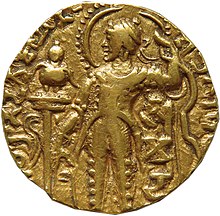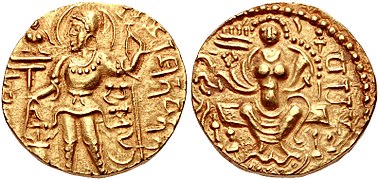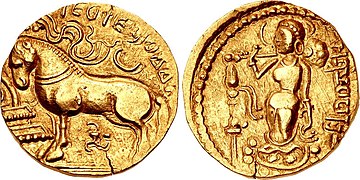The Powerful Samudragupta.
Samudragupta
| Samudragupta | |
|---|---|
| Maharajadhiraja | |

Coin of Samudragupta, with Garuda pillar, emblem of Gupta Empire
| |
| Gupta Emperor | |
| Reign | c. 335/350-375 CE |
| Predecessor | Chandragupta I, possibly Kacha |
| Successor | Chandragupta II, possibly Ramagupta |
| Spouse | Dattadevi |
| Issue | Chandragupta II, possibly Ramagupta |
| House | Gupta dynasty |
| Father | Chandragupta I |
| Mother | Kumaradevi |
| Gupta Empire 320 CE–550 CE | ||||||||||||||||||||||||||||||||||||
|---|---|---|---|---|---|---|---|---|---|---|---|---|---|---|---|---|---|---|---|---|---|---|---|---|---|---|---|---|---|---|---|---|---|---|---|---|
| ||||||||||||||||||||||||||||||||||||
Samudragupta (r. c. 335/350-375 CE) was a ruler of the Gupta Empire of present-day India. As a son of the Gupta emperor Chandragupta I and the Licchavi princess Kumaradevi, he greatly expanded his dynasty's political power.
The Allahabad Pillar inscription, a prashasti (eulogy) composed by his courtier Harishena, credits him with extensive military conquests. It suggests that he defeated several kings of northern India, and annexed their territories to his empire. He also marched along the south-eastern coast of India, advancing as far as the Pallava kingdom. In addition, he subjugated several frontier kingdoms and tribal oligarchies. His empire extended from Ravi River in the west to the Brahmaputra River in the east, and from the Himalayan foothills in the north to central India in the south-west; several rulers along the south-eastern coast were his tributaries.
Samudragupta performed the Ashvamedha sacrifice to prove his imperial sovereignty, and according to his coins, remained undefeated. His gold coins and inscriptions suggest that he was an accomplished poet, and also played music. His expansionist policy was continued by his son Chandragupta II.
Period
Modern scholars variously assign the start of Samudragupta's reign from c. 319 CE to c. 350 CE.
The inscriptions of the Gupta kings are dated in the Gupta calendar era, whose epoch is generally dated to c. 319 CE. However, the identity of the era's founder is a matter of debate, and scholars variously attribute its establishment to Chandragupta I or Samudragupta. Chandragupta I probably had a long reign, as the Allahabad Pillar inscription suggests that he appointed his son as his successor, presumably after reaching an old age. However, the exact period of his reign is uncertain. For these reasons, the beginning of Samudragupta's reign is also uncertain.
If Samudragupta is regarded as the founder of the Gupta era, his ascension can be dated to c. 319-320 CE.[4] On the other hand, if his father Chandragupta I is regarded as the founder of the Gupta era, Samudragupta's ascension must be dated to a later date. Samudragupta was a contemporary of king Meghavarna of Anuradhapura Kingdom, but the regnal period of this king is also uncertain. According to the traditional reckoning adopted in Sri Lanka for Buddha's death, he ruled during 304-332 CE; but the modified chronology adopted by modern scholars such as Wilhelm Geiger assigns his reign to 352-379 CE. Accepting the former date would place Samudragupta's ascension to c. 320 CE; accepting the latter date would place it around c. 350 CE.
The end of Samudragupta's reign is also uncertain.[3] Samudragupta's granddaughter Prabhavatigupta is known to have married during the reign of his son Chandragupta II, in c. 380 CE (assuming c. 319 CE as the epoch of the Gupta era). Therefore, the end of Samudragupta's reign can be placed before this year.
Various estimates of Samudragupta's regnal period include:
- A. S. Altekar: c. 330-370 CE
- A. L. Basham: c. 335-376 CE
- S. R. Goyal: c. 350-375 CE
- Tej Ram Sharma: c. 353-373 CE
Military career
The Gupta inscriptions suggest that Samudragupta had a remarkable military career. The Eran stone inscription of Samudragupta states that he had brought "the whole tribe of kings" under his suzerainty, and that his enemies were terrified when they thought of him in their dreams. The inscription does not name any of the defeated kings (presumably because its primary objective was to record the installation of a Vishnu idol in a temple), but it suggests that Samudragupta had subdued several kings by this time. The later Allahabad Pillarinscription, a panegyric written by Samudragupta's minister and military officer Harishena, credits him with extensive conquests. It gives the most detailed account of Samudragupta's military conquests, listing them in mainly geographical and partly chronological order. It states that Samudragupta fought a hundred battles, acquired a hundred wounds that looked like marks of glory, and earned the title Prakrama (valourous). The Mathura stone inscription of Chandragupta II describes Samudragupta as an "exterminator of all kings", as someone who had no equally powerful enemy, and as a person whose "fame was tasted by the waters of the four oceans".
Modern scholars offer various opinions regarding Samudragupta's possible motivations behind his extensive military campaigns. The Allahabad Pillar inscription suggests that Samudragupta's aim was the unification of the earth (dharani-bandha), which suggests that he may have aspired to become a Chakravartin (a universal ruler). The Ashvamedhaperformances by the Nagas, whom he defeated, may have influenced him as well. His southern expedition may have been motivated by economic considerations of controlling the trade between India and South-East Asia.
Early victories
The early portion of the Allahabad Pillar inscription mentions that Samudragupta "uprooted" Achyuta, Nagasena, and a ruler whose name is lost in the damaged portion of the inscription. The third name ends in "-ga", and is generally restored as Ganapati-naga, because Achyuta-nandin (presumably same as Achyuta), Nagasena, and Ganapati-naga are once again mentioned in the later part of the inscription, among the kings of Aryavarta (northern India) defeated by Samudragupta. These kings are identified as the rulers of present-day western Uttar Pradesh (see below). According to the inscription, Samudragupta reinstated these rulers after they sought his forgiveness.
It is not clear why the names of these three kings is repeated later in the inscription. According to one theory, these three kings were vassal rulers who rebelled against Samudragupta after the death of his father. Samudragupta crushed the rebellion, and reinstated them after they sought his forgiveness. Later, these rulers rebelled once more, and Samudragupta defeated them again. Another possibility is that the author of the inscription thought it necessary to repeat these names while describing Samudragupta's later conquests in Aryavarta, simply because these kings belonged to that region.
Samudragupta dispatched an army to capture the scion of the Kota family, whose identity is uncertain. The Kotas may have been the rulers of present-day Punjab, where coins bearing the legend "Kota", and featuring a symbol of Shivaand his bull, have been discovered.
The inscription states that the Gupta army captured the Kota ruler, while Samudragupta himself "played" (or pleased himself) in a city called Pushpa (the name Pushpa-pura referred to Pataliputra at Samudragupta's time, although it came to be used for Kanyakubja in the later period). Modern scholars have interpreted the word "played" in various ways: According to one theory, this portion describes Samudragupta's achievements as a prince. An alternative interpretation is that Samudragupta dispatched his army on these campaigns, while he himself stayed at the capital. It is also possible that the poet intended to convey that these campaigns were minor affairs that did not require the king's direct involvement at the battlefront.
Southern conquests
According to the Allahabad Pillar inscription, Samudragupta captured (and later released) the following kings of Dakshinapatha, the southern region:
- Mahendra of Kosala
- Vyaghra-raja of Mahakantara
- Mantaraja of Kurala
- Mahendragiri of Pishtapura
- Svamidatta of Kottura
- Damana of Erandapalla
- Vishnugopa of Kanchi
- Nilaraja of Avamukta
- Hastivarman of Vengi
- Ugrasena of Palakka
- Kubera of Devarashtra
- Dhananjaya of Kusthalapura
Extent of the empire
Samudragupta's empire included a core territory, located in northern India, which was directly controlled by the emperor. Besides, it comprised a number of monarchical and tribal tributary states. Historian R. C. Majumdar theorizes that Samudragupta directly controlled an area extending from the Ravi River (Punjab) in the west to the Brahmaputra River (Bengal and Assam) in the east, and from the Himalayan foothills in the north to the Vindhya hills in the south. The south-western boundary of his territory roughly followed an imaginary line drawn from present-day Karnal to Bhilsa.
In the south, Samudragupta's empire definitely included Eran in present-day Madhya Pradesh, where his inscription has been found. The Allahabad Pillar inscription suggests that he advanced up to Kanchipuram in the south. However, since the claims in the Allahabad Pillar inscription are from a royal eulogy, they must be treated with caution. The southern kings were not under his direct suzerainty: they only paid him tribute.
According to historian Kunal Chakrabarti, Samudragupta's military campaigns weakened the tribal republics of present-day Punjab and Rajasthan, but even these kingdoms were not under his direct suzerainty: they only paid him tribute. Samudragupta's claim of control over other kings is questionable. Historian Ashvini Agrawal notes that a gold coin of the Gadahara tribe bears the legend Samudra, which suggests that Samudragupta's control extended up to the Chenab river in the Punjab region.
Some earlier scholars, such as J. F. Fleet believed that Samudragupta had also conquered a part of Maharashtra, based on the identification of Devarashtra with Maharashtra, and Erandapalla with Erandol, where some Gupta-era remains have been found. However, this theory is no longer considered correct.
Coinage
- Coins of Samudragupta
The following types of Samudragupta's coins have been discovered:
- Standard type
- Obverse legend: Samara-shata-vitata-vijayo-jita-ripurajito-divam-jayati. Translation: "The unconquered one who has conquered his enemies [and] has continuously attained victories in a hundred battles, wins heaven; " Alternative translation: "The conqueror of the unconquered fortresses of his enemies, whose victory was spread in hundreds of battles, conquers heaven".
- Reverse legend: Prakramah
- Archer type
- Depicts Samudragupta standing fully dressed with a bow on his left hand and an arrow on his right hand.
- Obverse legend: Apratiratha vijitya kshitim sucharitair (or avnipatir) divam Jayati. Translation: "Unopposed by hostile chariots, conquering the earth, he conquers heaven by his good deeds".
- Reverse legend: Apratirathah
- Battle-axe type
- Obverse legend: Kritanta-parshur-jayatyajitarajajetaji-tah. Translation: "Wielding the axe of Kritanta (the god of death), the unconquered conqueror of unconquered kings is victorious"
- Reverse legend: Kritanta-parashuh
- Tiger-slayer type
- Depicts the king wearing turban and waist-cloth, and trampling a tiger
- Legend: Vaghra-prakramah. Translation: "Having the prowess of a tiger".
- Lyrist type
- Depicts Samudragupta wearing waist-cloth and seated cross-legged on a couch, playing a veena that lies on his knees.
- Legend: the king's name
- Ashvamedha type
- Obverse legend: Rajadhirajah prithvim avitva divam jayatyahritavaji-medhah ("the overlord of kings, who has performed the horse-sacrifice, having protected the earth, conquers the heaven") on the reverse.
- Some coins have an alternative legend: Rajadhirajah prithvim avitva divam jayatya-prativarya-viryah ("the overlord of kings, of irresistible valour, having protected the earth, wins heaven").
- Reverse legend: Ashvamedha-prakramah ("possessing the valour to perform the horse sacrifice")
Numismatist John Allan believed that the gold coins bearing the portraits of Chandragupta and Kumaradevi were issued by Samudragupta to commemorate his parents, but the later scholars have attributed the issue of these coins to Chandragupta.
Inscriptions
Two inscriptions from Samudragupta's reign have been discovered:
- Allahabad Pillar inscription
- Eran stone inscription
Fleet theorized that the Allahabad Pillar inscription was posthumous, and was issued during the reign of Chandragupta II, but modern scholars disagree with this theory.
Two other records are attributed to Samudragupta's reign, but the genuineness of these records is disputed:
- Nalanda inscription, dated to the regnal year 5
- Gaya inscription, dated to the regnal year 9
Both these inscriptions state that they were written at the order of the Gupta officer Gopaswamin. Like the Mathura stone inscription of Chandragupta II, these records describe Samudragupta as the "restorer of the Ashvamedha sacrifice". It seems suspicious that records issued so early in Samudragupta's reign mention this claim, which does not appear in the later Allahabad Pillar inscription. One possibility is that these records were issued during Samudragupta's reign, and were damaged after sometime, because of which they were restored during the reign of Chandragupta II.
Religion
Samudragputa's Eran inscription records the installation of a Vishnu idol in a temple. The Nalanda and Gaya inscriptions attributed to Samudragupta explicitly call him a devotee of Vishnu (parama-bhagavata), but the authenticity of these inscriptions is doubtful. He was also tolerant towards Buddhism, and permitted the construction of a Buddhist monastery commissioned by the Anuradhapura king Meghavarna at Bodh Gaya in his territory.
The Allahabad Pillar inscription states that Samudragupta was engaged in the performance of the Brahmanical ceremonies of Sattra (Soma sacrifices) and Diksha. It describes him as "the giver of many hundreds of thousands of cows". The Mathura stone inscription of his son Chandragupta II also describes him as the giver of "millions of cows and gold". It appears that Samudragupta donated these cows to the Brahmins who officiated his Sattra and Diksha ceremonies.[99] The Eran inscription states that Samudragupta surpassed Prithu, Raghava and other legendary kings in giving gold.
The Allahabad Pillar inscription alludes to his divine kingship, comparing him to the Parama Purusha (supreme being), and also with deities such as Dhanada (Kubera), Varuna, Indra, and Antaka (Yama). The Eran inscription states that he was equal to Kubera and Yama in pleasure and anger respectively. The Mathura stone inscription similarly describes him as equal to the deities Kubera, Varuna, Indra, and Yama.
Personality
Samudragupta's coins depict him as a man of tall stature and muscular physique. The Allahabd Pillar inscription presents him as a compassionate ruler, stating that his "mind was engaged in providing relief to the low, the poor, the helpless, and the afflicted". It also mentions that he reinstated many royal families which had lost their kingdoms, including the kings defeated by him. At the same time, it states that he maintained strict administration ("prachanda shasana").
The inscription states that Samudragupta became famous among the learned people because of his poetical works, and earned the epithet "king of poets". This suggests that he composed some poetical works, but none of these works now survive.
The inscription also boasts that Samudragupta put to shame the celestial musician Tumburu and Narada by his lovely performances of music. Samudragupta's musical talents are also corroborated by his gold coins which depict him playing a veena.
The inscription praises Samudragupta's wisdom and intellect, stating that he put to shame the preceptor of the Lord of the Gods (that is, Brihaspati) by his sharp intellect.
Succession
The official records of the Gupta dynasty state that Samudragupta was succeeded by Chandragupta II, who was his son from queen Dattadevi. Based on a reconstruction of the partially-lost Sanskrit play Devichandraguptam, a section of modern historians believe that Samudragupta was succeeded by Ramagupta, who was later dethroned by Chandragupta II







Comments
Post a Comment